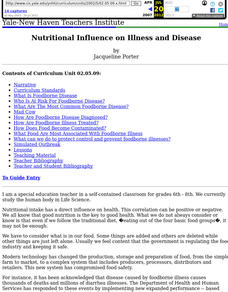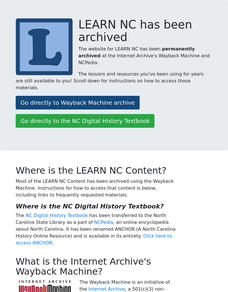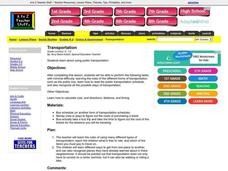Curated OER
Foods and Languages of the World
Students celebrate diversity. In this multicultural appreciation lesson, students celebrate diversity by sampling food from different cultures, learning a few words in Spanish and identifying the seven different continents.
Curated OER
Physical Differences
Students examine physical differences amongst themselves. In this diversity lesson, students read the book We're Different, We're the Same. Students name things about their appearance that is different from the person next to them.
Curated OER
Reading the Biography
Students explore the lives of famous Americans. In this biography lesson, students read biographies about famous Americans and keep reading journals as they read about setting, main events, and character sketches.
Curated OER
Vocabulary and Language Development
Learners discover new vocabulary words. In this language development lesson, students reach into a box of themed items and identify the object. They discuss the attributes of the object as well.
Curated OER
What's in My Kitchen?
Students examine a variety of kitchen utensils. For this wood and alternative materials instructional activity, students view examples of kitchen utensils, sort kitchen utensils, discuss the benefits of using one utensil over the other...
Curated OER
Odd and Even Numbers
First graders practice number identification by reading a story in class. In this number sense lesson, 1st graders read the story A Wish for Wings that Work and identify objects within the book's photographs. Students count the number of...
Curated OER
Polynomials: Addition
Students add polynomials both vertically and horizontally. In this algebra lesson, students practice adding polynomials. The included worksheet has 27 problems, and includes the answers. To access the worksheet, the teacher will need to...
Curated OER
The Itsy Bitsy Spider
Students sing the song The Itsy Bitsy Spider and complete movements with the song. In this song lesson plan, students are assessed on if they sing the song in the correct order or not.
Curated OER
Producers, Consumers, and the Food Chain
Third graders discuss producers, consumers, and the food chain. In this producers and consumers lesson plan, 3rd graders talk about organisms, the food chain, and the difference between producers and consumers. They complete review...
Curated OER
Different Types Of Bugs
First graders create their own bug that contain the different characteristics that a bug can have. In this bugs lesson plan, 1st graders first list 3 - 5 characteristics before they create their bug.
Curated OER
Best lesson in the whole world!
Students study the concept of fraction using mathematical reasoning. In this problem solving fraction lesson, students use various methods to explain their reasoning in solving fractions. Students use a number of different prompts to...
Curated OER
Microbes & History: Microbial influence on the spread of Civilization
Young scholars explore how to extract plant fibers from the flax plant Linum usitatissimum in the process of making linen fibers. Doing so spark interest in the importance of microbial action on the spread of human culture and civilization.
Curated OER
Migrating Monarchs and Trekking Timber wolves on the Internet
Students learn and observe the life cycle of a monarch butterfly. They explore how wolves maintain complex social structure through scent, communications, and postures.
Curated OER
Koala Lou: A Lesson on Love From Australia
Students will learn how family members can help and support each other as they listen to the story Koala Lou by Mem Fox. They will also learn about Australia as they study the animals illustrated in the book.
Curated OER
Nutritional Influence on Illness and Disease
Students examine nutritionally related diseases and illnesses, evaluating studies and developing topics for a science fair project. They investigate bacteria, researching how it can be harmful or helpful, and create illustrated displays.
Curated OER
The Me Book
Learners relate to the pictures as symbols so that they come to point to named pictures, explain what pictured objects are for, match pictures to real objects, categorize objects, and recognize words.
Curated OER
PowerPoint Homophones
Student identify homophones. Students, in pairs, work together to create a PowerPoint presentation using pictures to show the difference between the words. The PowerPoint can then be used by all the students in lower grade levels.
Curated OER
Fulcrums in Our Body
Second graders discuss fulcrums and levers and identify at least two fulcrums and levers on their bodies. They also identify fulcrums and levers on animal bodies.
Curated OER
The Way Editorial Cartoons Work
Twelfth graders interpret visual language found in political cartoons.
Curated OER
Rainbow Spelling (Kinesthetic Approach To Encoding)
Second graders demonstrate their encoding skills by spelling words using color coded paper, match correct letters with the colored paper to spell the words in standard form, and self correct any errors made in the spelling with colored...
Curated OER
Where Oh Where
Young scholars read a current event article orally and make connections regarding the geographic themes of the newspaper location. In this current event article lesson, students use a map to locate where the event from their article took...
Curated OER
Transportation
Students examine the different types of transportation. They practice reading a bus schedule and identifying which direction the bus is traveling. They also calculate cost of the ride and how long the ride is.
Curated OER
Addition and Subtraction in Center Time
First graders use bean bags, dominos, number trains, counters, paper clips, flashcards, beads and more in a variety of centers to practice basic addition and subtraction facts.

























